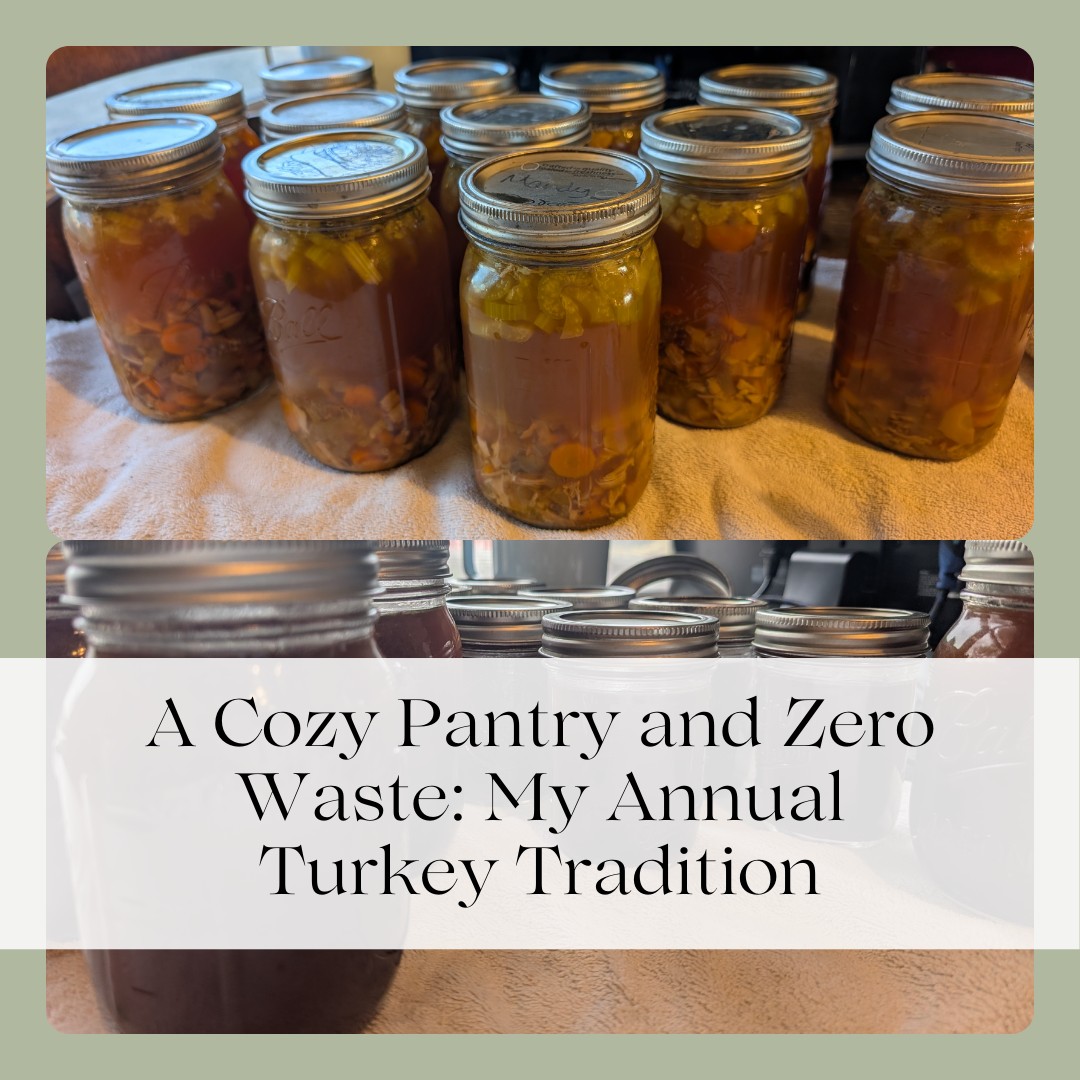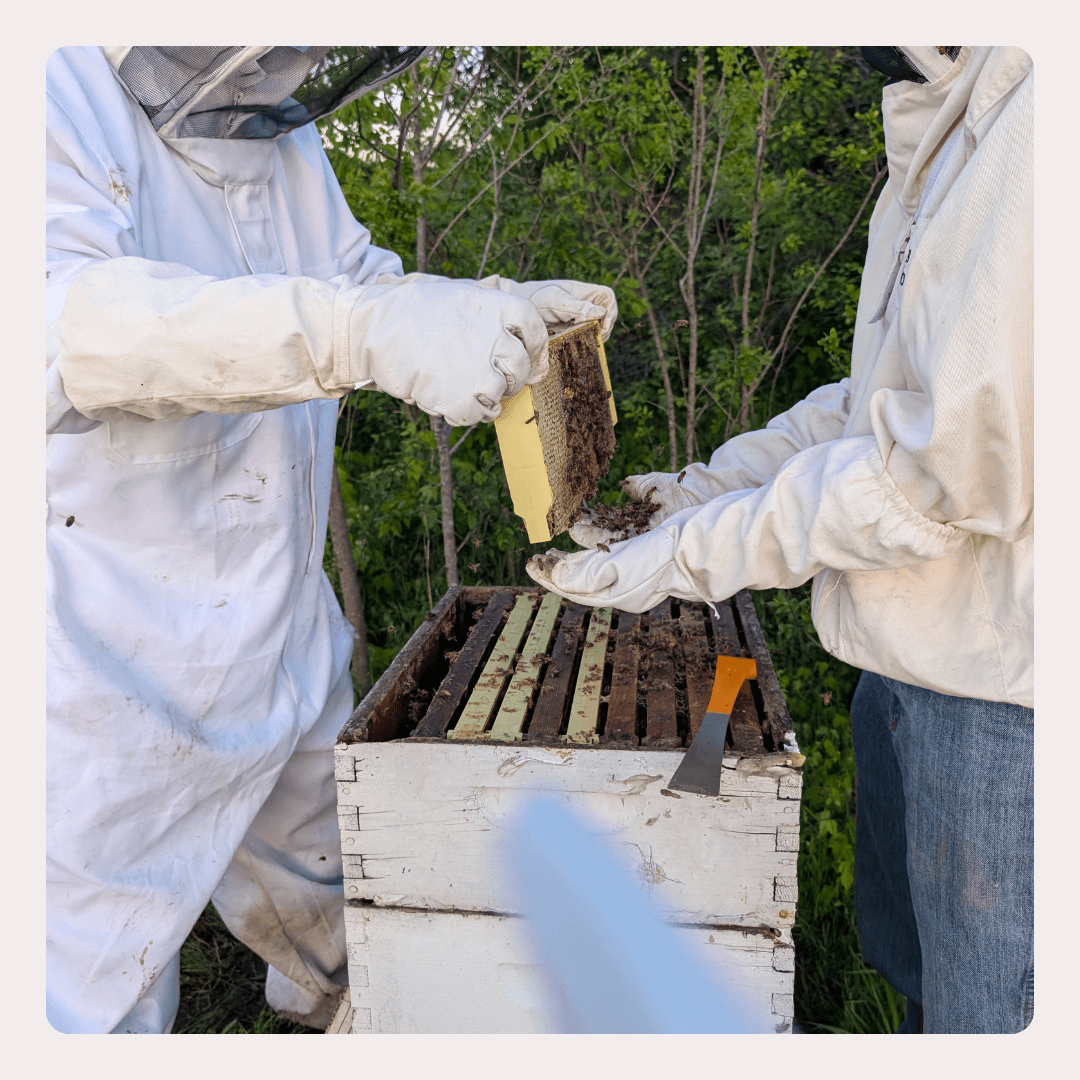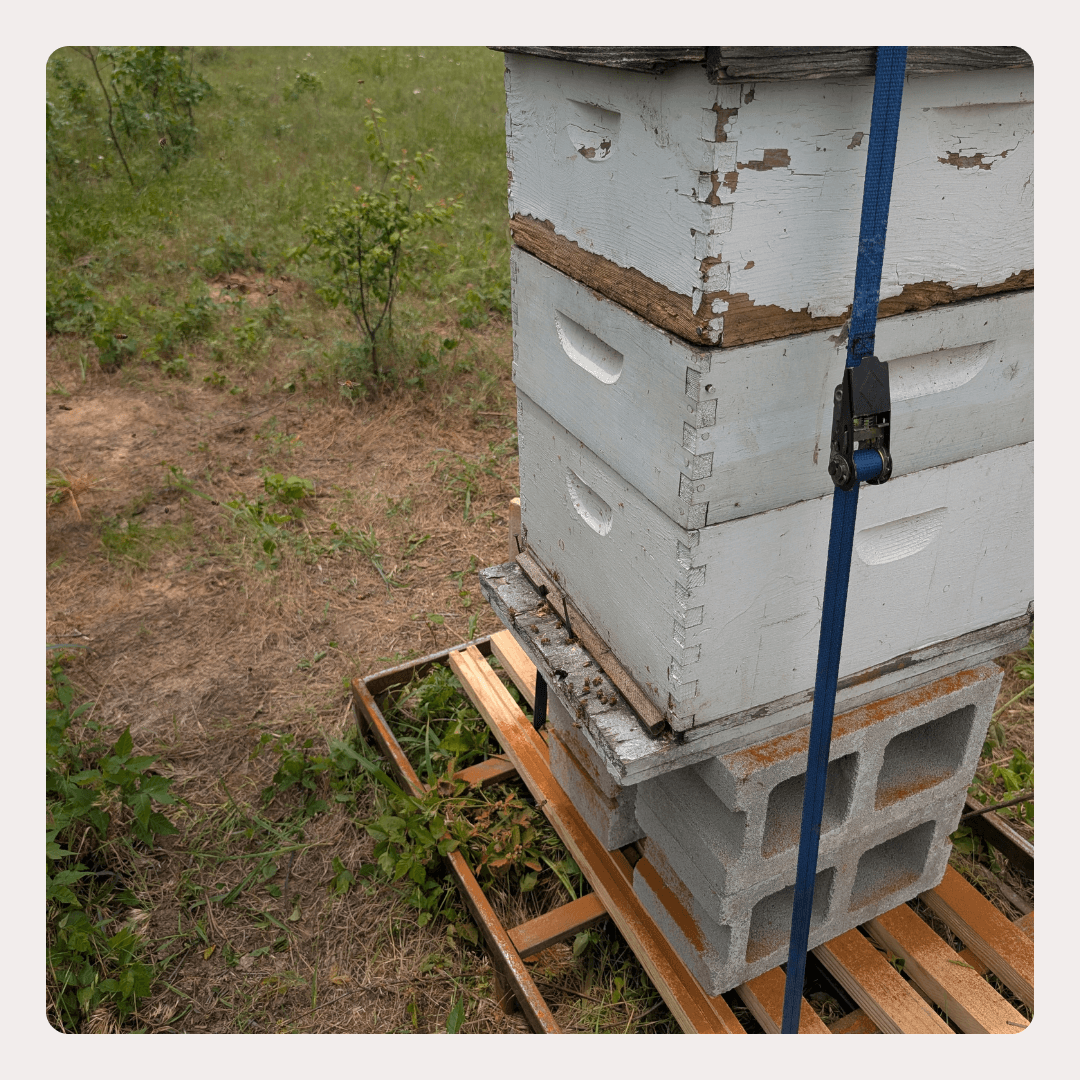
It's that time of year where we have big meals, fully bellies, and lots of left overs. A few years ago I started making turkey bone broth with the left over carcass. I have also canned turkey soup from the left over turkey meat. There have been a few years where we had an extra turkey that we just stored in the freezer, with the intent of pulling it out later and having a few more turkey meals. But, the reality is that it never happens that way. Every year I end up with another turkey in the freezer just waiting to be cooked. So this year I had the idea of just cooking them all...which happened to be almost 2 1/2 turkeys' worth of meat, bones, the works!
Yes, at one point I wondered what I was thinking with this brilliant idea I had. But now that it's all said and done, I'm glad I chose to just do it all at once. One big mess, then 3 rounds of canning, and I'm officially done with dealing with all that turkey!
Here's the breakdown of how that all worked:
We used 2 roasters. Each one had a full turkey in it (15ish pounds or more) and then one of them also had a turkey breast with the bone, so roughly another 1/2 turkey. We made our regular Thanksgiving day meal. Then we took all the meat off the bones to store in the fridge. With the carcasses, we used both roasters and made a few gallons worth of bone broth. I like to let mine brew at least 24 hours, usually closer to 48 hrs. I then take the broth and strain it into jars. Once the jars are cooled, I place them in the refrigerator for a day or so, so that the fat can rise to the top and I can easily scrape it off. I store the fat in another jar in the fridge to use in other meals.
While I'm waiting for my broth to chill, I usually make up a large batch of turkey soup (no noodles) and can it up for use throughout the year. This year I had about 3 canners worth of turkey soup. 19 quarts and 14 pints to be exact. And that's just the ones that canned properly. I ended up with 1 quart and 1 pint size jar that didn't seal properly. So they went into the fridge and we had them as a meal on another night.
Next up was canning the broth. I usually can it all in pint size jars because I rarely need more than 2 cups worth at a time. It's so concentrated that I usually dilute it and still have plenty of flavor. This year I decided to can both pint and half-pint sizes. I had 8 jars of each.
That may seem like a LOT of canned goods of the same thing, but I like to share! So my mom will get some, my daughter will have some to enjoy, and I'll probably even take a small jar of soup to my Granny. That's the joy of canning...everyone can benefit and enjoy it! And very little food has to go to waste! I love having a want not-waste not kitchen!
🌸 From my homestead heart to yours —
If you’re walking this same journey of homemaking, decluttering, and creating a peaceful, faith-filled home, you’re not alone.
I’d love to share encouragement, simple living inspiration, and homestead wisdom with you — right to your inbox.
If you’re walking this same journey of homemaking, decluttering, and creating a peaceful, faith-filled home, you’re not alone.
I’d love to share encouragement, simple living inspiration, and homestead wisdom with you — right to your inbox.
– Amanda | The HomeGrown Mom 🌾

For years I have been working towards decluttering and organizing my home. But I always got stuck. I'd go through a couple of boxes, get stuck, and push them aside again until next time. I'm not really sure what got into me this time around. But I have had the BEST progress I've ever had this time around.
I finally decided to tackle the storage area of our house, which just so happens to be in our master bedroom. We have no garage, because our master bedroom is in what used to be a 2-car garage. While it's amazing to have such a large area for our bedroom, it's not always so nice to not have that extra bit of storage space. I kept saying "just one more shelf and I can take care of this"...But this time, instead of saying that, I actually found myself with EXTRA space on my current shelves.
Here's the breakdown: 5, 5-shelf wire shelves (approximately 6ft tall), and lots of floor space covered with extra boxes, luggage, laundry baskets, you get the idea. On day 3 of decluttering, I was able to go through 3 of the shelf units (the other 2 have mainly tools and my husbands things). Between the 3 shelves and things on the floor, I was able to get rid of 1 big bag and several boxes (stacked within each other and other trash added) of trash. Not because it was all gross and nasty things we were hanging onto. But more so that it was things that we thought we'd fix or reuse somehow and I now finally realize that isn't going to happen. Another couple of bags and boxes to donate, and another 4 boxes of things to donate to our homeschool group. All together, that's well over 10 boxes of stuff. That's just crazy!
I still have a few things to go through. My brain hit it's limit and I needed to put a few things aside for next time. But, I now have a floor and even some room on the shelves. I'm so amazed at all I've been able to accomplish this time around.
If you’re in the middle of your own decluttering journey, don’t lose heart. Progress doesn’t always happen all at once—it happens one box, one shelf, and one small decision at a time. Give yourself grace, celebrate the victories (even the small ones), and keep going. You’ll be amazed how freeing it feels when you can finally breathe in your own space again.
🌸 From my homestead heart to yours —
If you’re walking this same journey of homemaking, decluttering, and creating a peaceful, faith-filled home, you’re not alone.
I’d love to share encouragement, simple living inspiration, and homestead wisdom with you — right to your inbox.
If you’re walking this same journey of homemaking, decluttering, and creating a peaceful, faith-filled home, you’re not alone.
I’d love to share encouragement, simple living inspiration, and homestead wisdom with you — right to your inbox.
– Amanda | The HomeGrown Mom 🌾

Some days don't go as planned. And when you live with an unseen illness that sometimes acts like an autoimmune disease, some days it just knocks you down. I've learned to listen to my body. Yes, it's frustrating. But if I allow my body to take it easy on the days it's screaming at me, then my body recoups that much faster. Thankfully I am able to work from home as a homemaker/homesteader. Yes, there are still routine things that have to be done, like feeding the rabbits, making meals, general clean-up, but the extra things on my list like deeper cleaning and organizing, extra things in the garden, or even using extra brain power to learn new skills are all things that I can put aside while I let my body rest.
I thought this round of a Lyme flareup would go quickly. After all, my body has already done the hard work of fighting it off once...and after having it for likely 15+ years before it was realized. So shouldn't a simple flareup be a fairly quick and easy fix? Well, yes and no. It's fairly "easy" because I now have routine appointments and we are able to catch it quickly. However, true to it's nature, my body has to take some of the treatments slowly. For this round, that looks like a few extra days of taking 1/3 of the dose I am working up to on my immune-boosting, body detoxing supplement. But that's ok, because I know that I'll get there and that my body is doing what it needs to do, even if it is a little slow doing it...and makes me feel very blah in the process.
I am thankful that I am able to allow myself these slower days and that my family is fully supportive of me during these times. I'm also thankful that I have things I can do while taking it easy, like computer work, crochet, reading. It's very important to find things to do during this time. It makes it so much easier to believe that I'm not being lazy, but that I'm healing. As a mom, that seems to be an extra hard thing to believe.
These days of rest aren’t easy, especially when the world keeps spinning and responsibilities don’t pause. But I’m learning that rest is not a setback—it's part of the journey. It’s a necessary rhythm for healing, especially for those of us with bodies that have fought long battles. If you're in a similar season, please know this: you're not lazy, you're healing. Give yourself permission to pause, to breathe, and to trust that the work you're doing—both seen and unseen—is enough for today. 💛
🌸 From my homestead heart to yours —
If you’re walking this same journey of homemaking, decluttering, and creating a peaceful, faith-filled home, you’re not alone.
I’d love to share encouragement, simple living inspiration, and homestead wisdom with you — right to your inbox.
If you’re walking this same journey of homemaking, decluttering, and creating a peaceful, faith-filled home, you’re not alone.
I’d love to share encouragement, simple living inspiration, and homestead wisdom with you — right to your inbox.
– Amanda | The HomeGrown Mom 🌾

Our homestead is still growing, despite us having no land of our own. But we are determined to keep moving forward. We are actively looking for land to call our own. In the meantime, we are doing our best to find ways for our homestead to pay for itself.
We currently have 29 goats, 4 rabbits, 1 beehive, and a garden...and a couple of cows we share with a friend. We have a plan for teaching different classes such as canning, making kombucha, baked goods, apple scrap vinegar, how to crochet, and whatever else we can think of. We will be teaching these locally for in-person classes. But we will also be making these into online courses. So if you aren't local and are interested, stay tuned! Good things are coming!!
I am also, on a local level, making home-baked goods like jumbo muffins and healthy granola bars. These are things I make for my family on a weekly basis, so it makes sense to just up my quantity and sell the extra baked goods.

My guys have also built a variety of things for our homestead, including a bunny tractor, dog feeder (to keep the goats out of the dog food), garden beds, and more. These are items that will be made and sold locally, but we will also be putting together the plans in a pdf form for purchase so that you can build your own.
Trust me when I say that no matter where you live, you can build your homestead one step at a time. We may be doing this whole thing backwards...after all, we still tote everything around in our mini-van, even goats! But we are making our dreams come true, one goat, one homemade muffin, one online course at a time.
Trust me when I say that no matter where you live, you can build your homestead one step at a time. We may be doing this whole thing backwards...after all, we still tote everything around in our mini-van, even goats! But we are making our dreams come true, one goat, one homemade muffin, one online course at a time.
Here's to No-Land Homesteading!
🌸 From my homestead heart to yours —
If you’re walking this same journey of homemaking, decluttering, and creating a peaceful, faith-filled home, you’re not alone.
I’d love to share encouragement, simple living inspiration, and homestead wisdom with you — right to your inbox.
If you’re walking this same journey of homemaking, decluttering, and creating a peaceful, faith-filled home, you’re not alone.
I’d love to share encouragement, simple living inspiration, and homestead wisdom with you — right to your inbox.
– Amanda | The HomeGrown Mom 🌾

We have been wanting bees for quite some time now. After all, who doesn't love fresh, local honey? My family just can't get enough. Thankfully, we were able to get started with an established hive. And, as with everything else on our growing little homestead, attaining these bees was quite different than you might think. The only vehicle we had to transport them in was, you guessed it, our minivan.
It was just over an hour long drive, so we  wanted to ensure that the bees stayed where they belonged. My guys were on the mission. They properly closed up the hive after dark, then used a tight mesh fabric to keep them all together in the chance that some of the bees got out. Where there's a will, there's a way!
wanted to ensure that the bees stayed where they belonged. My guys were on the mission. They properly closed up the hive after dark, then used a tight mesh fabric to keep them all together in the chance that some of the bees got out. Where there's a will, there's a way!
Since it was so dark, and a storm was about to hit, they placed the bee in a temporary spot. However, we can only move the bees a little at a time (3 feet to be exact) unless we are moving them onto another land all together. I think at this point, we have now moved them about 3 times, a few feet at a time.
 wanted to ensure that the bees stayed where they belonged. My guys were on the mission. They properly closed up the hive after dark, then used a tight mesh fabric to keep them all together in the chance that some of the bees got out. Where there's a will, there's a way!
wanted to ensure that the bees stayed where they belonged. My guys were on the mission. They properly closed up the hive after dark, then used a tight mesh fabric to keep them all together in the chance that some of the bees got out. Where there's a will, there's a way!Since it was so dark, and a storm was about to hit, they placed the bee in a temporary spot. However, we can only move the bees a little at a time (3 feet to be exact) unless we are moving them onto another land all together. I think at this point, we have now moved them about 3 times, a few feet at a time.

We live in south central Oklahoma, which means lots of storms and high winds. Not only that, they also share a field with some cows that frequent the path. Needless to say, there are a few good reasons to make sure our hive is secure. We started out with just a few cinder blocks, then we strapped them down. This last time we added a metal frame to give them a little more stability.
To say that I am enjoying having bees is an understatement. At first I really just thought I'd be letting my guys handle them and bring me all the goods. But I'm realizing that I find it quite relaxing to visit the hive.
Yes, we are properly suited up...at least mostly. At the very least we are fully clothed and use a bee hat and veil.
I can't wait for our first harvest! Our bees have been quite busy. They seem to be thriving. We plan to add a few more hives as soon as we can. And, as is common on our little homestead, we will use every single bit of honey, wax, propolis, and anything else we can from our busy bees.

🌸 From my homestead heart to yours —
If you’re walking this same journey of homemaking, decluttering, and creating a peaceful, faith-filled home, you’re not alone.
I’d love to share encouragement, simple living inspiration, and homestead wisdom with you — right to your inbox.
If you’re walking this same journey of homemaking, decluttering, and creating a peaceful, faith-filled home, you’re not alone.
I’d love to share encouragement, simple living inspiration, and homestead wisdom with you — right to your inbox.
– Amanda | The HomeGrown Mom 🌾













